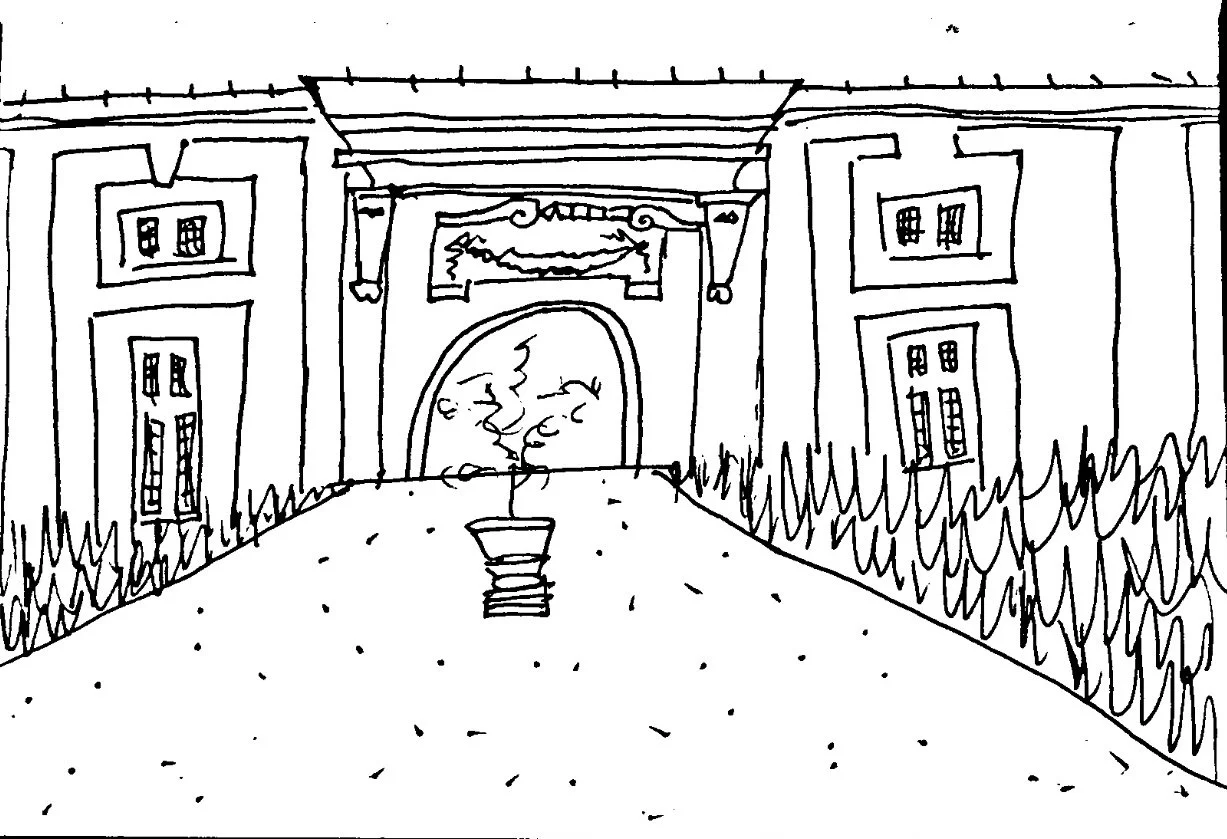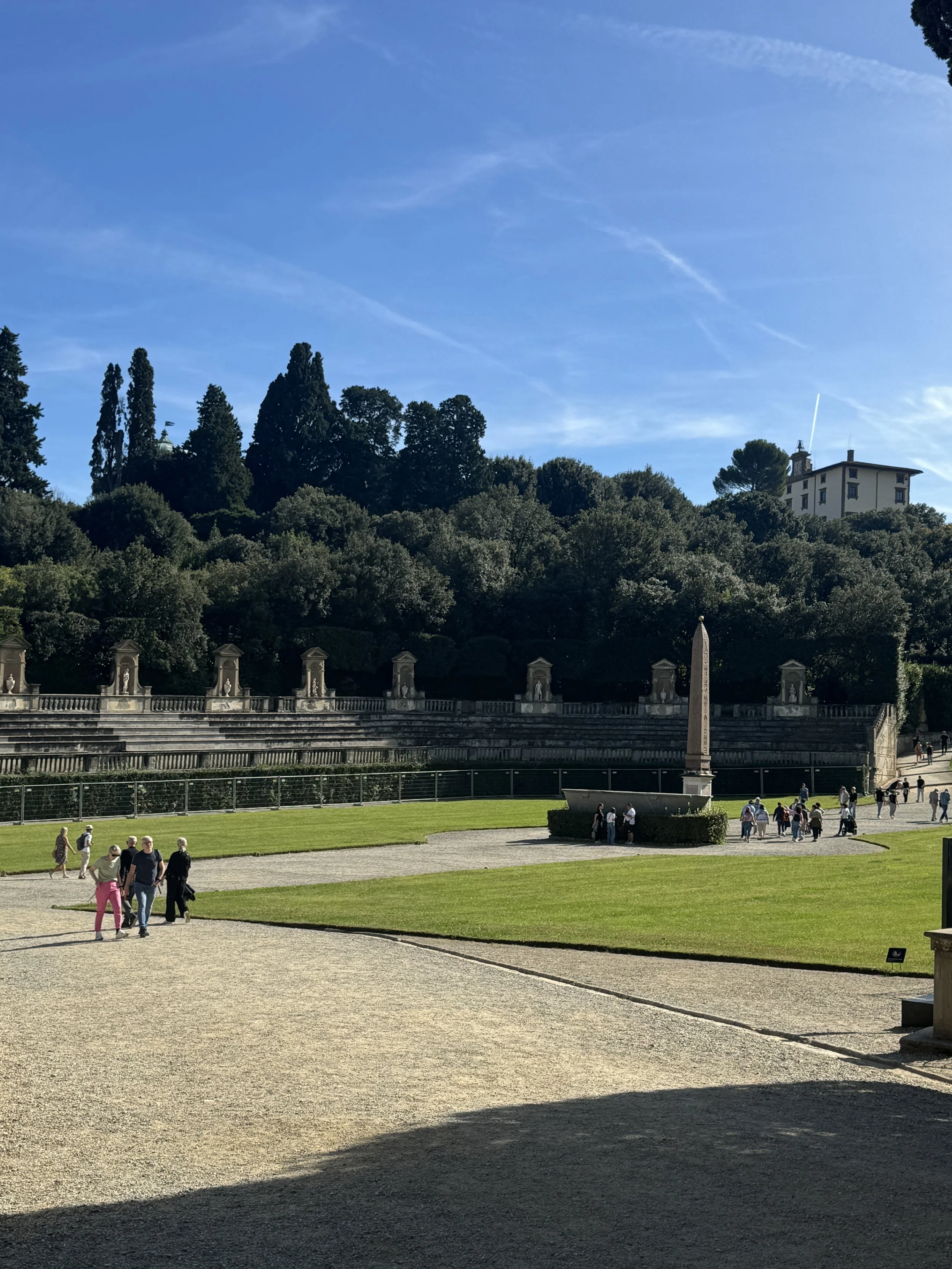The Political Influence of the Medici Family and Architectural Significance of the Boboli Gardens
-
Background
In 1549, Eleonora di Toledo, wife of Cosimo I de’ Medici, commissioned the architect Niccolò Tribolo to design an expansive garden behind the Pitti Palace in Florence, Italy. The result was the Boboli Gardens, a private, elevated space with sweeping views of the city, an unusual feature for the 16th century. Despite its grandeur, the garden remained exclusive to the Medici family, with no public access or recorded events until 1766. Over time, the Medicis enlisted multiple architects and imported numerous sculptures and artworks to shape the garden into a living monument of their legacy. This raises the central question: how do the architectural elements of the Boboli Gardens reflect the political and cultural ambitions of the Medici family during the Renaissance? Key features such as the horseshoe-shaped amphitheater and the Grotto of the Madama physically embody the family's influence and aesthetic ideals. As Mannerist architecture emerged in Italy in the 1520s, the Boboli Gardens evolved alongside it: embracing expressive, complex designs that would later inspire the Baroque style. Ultimately, the gardens served not only as a masterpiece of Mannerist design with Renaissance influence but also as a strategic expression of Medici power, blending politics, nature, and art into a lasting Italian symbol.
-
The Medici Family
In order to understand the creation of the Boboli Gardens, we must understand the uprising of the Medici family. Originally known as successful bankers, the Casa Medici became one of the most prosperous banking institutions in Europe, with branches in London all the way to Rome. Soon they forged alliances within the Florentine Signoria and maintained relationships with the papal court, and through those relationships the Medici family became politically successful. But, not in what one may picture. Their influence extended far beyond economics. Cosimo de’ Medici (1389–1464) recognized Florence’s potential to be more than a center of textile trade. Through art and architecture, he envisioned a city spiritually and aesthetically elevated by Renaissance ideals. His grandson, Lorenzo de’ Medici (1449–1492), became a pivotal patron of the arts, nurturing talents like Michelangelo Buonarroti, Leonardo da Vinci, and Sandro Botticelli. Without Lorenzo’s support, the Renaissance might have been deprived of masterpieces such as Michelangelo’s David or the impressive ceiling of the Sistine Chapel. Though the Medici fortune was built on banking, they came to view art as a form of capital. One that could secure their status politically, forge powerful alliances, and reshape Florence’s cultural identity. Through the Medici family, the city was forever transformed.
With time, the Boboli Gardens came to symbolize the grandeur and aesthetic ideals of the Italian Renaissance. Although construction began in the mid-16th century, the gardens were not fully completed until the 19th century. Eleonora di Toledo envisioned a culturally significant landscape behind the Pitti Palace, initiating its development with architect Nicolò Tribolo. After Tribolo's death, Bartolomeo Ammannati and Bernardo Buontalenti continued the work, and under Cosimo II, the gardens were expanded with a secondary axis stretching toward the Porta Romana. In 1637, classical statues and lush greenery were introduced around the amphitheater, enhancing its theatrical presence. At that time, the Fountain of the Ocean stood at the center of the theater but was later relocated to its own island, making room for the Egyptian obelisk, Tuscany’s oldest monument, dating back to 1500 BC. Over the centuries, additional paths, Roman sculptures, and architectural features were added, enriching the garden’s layered design. Finally, under the rule of Pietro Leopoldo di Lorena in the late 18th century, the Boboli Gardens were opened to the public for the first time, transforming a once-private Medici sanctuary into a shared cultural treasure.
-
Artesian Significance
Artistic expression in the Boboli Gardens reflects the Medici family's deep belief in art as a symbol of royalty and wealth. Far from just being decoration, the artworks enhance the landscape, transforming it into a living gallery. The garden’s greenery itself becomes part of the artistic narrative, which can be seen in features like the Cerchiate (branch archways), which guide visitors toward sculptural focal points such as the Island Basin. Commissioned by Cosimo II and designed by Giulio Parigi, the Island Basin is a large oval pool with a central island, crafted from marble and bronze. This island is accessed through two gated entrances and crowned with Capricorns, symbols of the Grand Duchy of Tuscany, pouring water into shell-shaped basins. At its heart stands the Fountain of Oceanus, surrounded by oak trees and hedges that frame mythological, Florentine folk, and historical figures sculpted by Renaissance artists. One such figure, a subject playing bagpipes, evokes the rustic entertainments once held by the Medici court within the gardens. Here, art is not only an aesthetic pursuit but a means of filling the space with purpose and spiritual resonance.
-
The Pitti Palace
When commissioned by Luca Pitti in 1458, the Pitti Palace showcased typical traits of early Renaissance architecture: symmetry and proportion, horizontal emphasis, and rusticated stonework. As seen above, the facade is organized into three horizontal tiers, each with even spaced windows and consistent proportions. The use of massive, rough-hewn stone blocks (called bugnato) gives the building a fortress-like aesthetic, typical of Florentine palaces. When the Medici family acquired the palace in 1549, they expanded it significantly, introducing Mannerist elements that broke from Renaissance traditions. Such as the increase in scale, the addition of the Boboli Gardens, and visual tension. The expansion under Bartolomeo Ammannati made the palace even more monumental, with exaggerated proportions that challenge the restraint we typically see in Renaissance architecture. The gardens reflect Mannerist ideals of artifice and controlled nature due to the axial paths and dramatic vistas. Mannerism often plays with unexpected spatial relationships which we can see in the palace’s layered additions and decorative flourishes.

-
The Ampitheatre
We then again see this in the Amphitheater, made around 1550 by Niccolò Pericoli Tribolo for Eleonora di Toledo. The amphitheatre began as a green theatre: a sculpted landscape space carved from the quarry that supplied stone for the Pitti Palace. The amphitheatre’s design follows a symmetrical, axial plan aligned with the palace, reflecting Renaissance ideals of proportion and harmony. Then, the idea of creating an amphitheatre for courtly entertainment and display is drawn from ancient Roman models, such as the colosseum. The amphitheatre was later enclosed and embellished between 1630–1634 under Giulio Parigi, commissioned by Ferdinando II de’ Medici. These renovations added a Mannerist touch on the amphitheater. A typical aspect of Mannerist architecture is visual complexity, through statues, elaborate ornamentation, and obelisks there are now layered visual aspects to the theatre. Parigi’s stone architecture added drama, turning the green theatre into a formal stage for spectacles. Lastly, the largest example of Mannerism is transforming raw nature into cultivated art, which we can see when the quarry was turned into a performance space.
-
The Lemon House
Designed about two centuries later, the Lemon House reflects the Enlightenment-era it was designed in. Built between 1777 and 1778 by architect Zanobi del Rosso for Grand Duke Pietro Leopoldo of Lorraine, the Lemon House has classical motifs, functional elegance, and blatant symmetry that creates order within the space. In contrast to the expressive intensity of the Boboli Gardens and the Pitti Palace, with their Mannerist complexity and Renaissance formality, the Lemon House embodies elegance, offering a moment of architectural stillness that all who come across feel. Unlike Mannerist structures that often feature visual tension and elaborate decoration, the Lemon House is more restrained, with its only expressional aspect being the lemon plants and personal garden it has. Its placement within the garden complements the landscape rather than dominating it, reflecting Enlightenment values of harmony with nature. Another key aspect of the construction of this building was on July 12, 1737, Francis Stephen of Lorraine (later Holy Roman Emperor Francis I) was installed as Grand Duke of Tuscany, founding the House of Habsburg-Lorraine in the region, and leaving the Medici family name in history. The transition from Medici to Habsburg-Lorraine rule brought new features to the garden. There became less care about dynastic display, but more about leisure for man and scientific aspects, reflective of the Enlightenment era and neoclassical architecture emergence.

-
Cultural Significance
The Boboli Gardens show how history and design can work together to create something powerful and lasting. The layout, sculptures, and architecture reflect the values of the Medici family and the cultural ideals of the Renaissance. Every path, fountain, and statue tells a story, not just about beauty, but about politics, power, and artistic ambition. This essay has explored how the garden’s design responds to its historical context, blending nature with art to express identity and influence. The Boboli Gardens became a model for other European landscapes, proving that architecture can shape how we understand history. In conclusion, this research highlights how gardens like Boboli are more than outdoor spaces, they are reflections of the time and people who built them. They help us see how design can carry meaning, preserve memory, and inspire future generations.
-
Political Significance
The Boboli Gardens show how politics can shape architecture in real, visible ways. One clear example is the Lemon House, which reflects how changes in government can directly affect how historic places are built, updated, and cared for. Its design, created during the rule of the Habsburg-Lorraine family, shows the shift toward Enlightenment ideas: favoring clean lines, useful spaces, and harmony with nature instead of flashy decoration. This change in leadership also influenced how parts of the garden were used. After 1739, the pit in the Boboli Amphitheatre stopped hosting public shows. The new rulers, especially Grand Duke Pietro Leopoldo, moved away from the big outdoor performances that the Medici family loved. Instead, they preferred smaller, indoor gatherings like music salons and opera houses, which matched the quieter, more thoughtful style of the time. As a result, the Boboli Gardens became less about showing off power and more about peaceful reflection and learning. The Lemon House, with its simple beauty and practical purpose, is a perfect example of this change. It wasn’t just built to protect lemon trees, it was also a symbol of how new political ideas could reshape the meaning of architecture and public space.
-
My review
Visiting the Boboli Gardens was a peaceful and enriching experience. The wide gravel paths, elegant sculptures, and carefully designed groves create a space where history and nature meet. I was struck by the balance between formal layout and natural beauty where every turn revealed a new fountain, statue, or quiet corner to pause and reflect. The gardens carry the legacy of the Medici family, offering insight into Renaissance ideals of harmony and grandeur. It’s a place that invites slow exploration, where art, architecture, and landscape come together to inspire calm and curiosity. I enjoyed it greatly.

